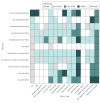Association Between Birth Defects and Cancer Risk Among Children and Adolescents in a Population-Based Assessment of 10 Million Live Births
- PMID: 31219523
- PMCID: PMC6587148
- DOI: 10.1001/jamaoncol.2019.1215
Association Between Birth Defects and Cancer Risk Among Children and Adolescents in a Population-Based Assessment of 10 Million Live Births
Erratum in
-
Erroneous Cohort Totals in Abstract.JAMA Oncol. 2019 Aug 1;5(8):1232. doi: 10.1001/jamaoncol.2019.3065. JAMA Oncol. 2019. PMID: 31393523 Free PMC article. No abstract available.
Abstract
Importance: Birth defects affect approximately 1 in 33 children. Some birth defects are known to be strongly associated with childhood cancer (eg, trisomy 21 and acute leukemia). However, comprehensive evaluations of childhood cancer risk in those with birth defects have been limited in previous studies by insufficient sample sizes.
Objectives: To identify specific birth defect-childhood cancer (BD-CC) associations and characterize cancer risk in children by increasing number of nonchromosomal birth defects.
Design, setting, and participants: This multistate, population-based registry linkage study pooled statewide data on births, birth defects, and cancer from Texas, Arkansas, Michigan, and North Carolina on 10 181 074 children born from January 1, 1992, to December 31, 2013. Children were followed up to 18 years of age for a diagnosis of cancer. Data were retrieved between September 26, 2016, and September 21, 2017, and data analysis was performed from September 2, 2017, to March 21, 2019.
Exposures: Birth defects diagnoses (chromosomal anomalies and nonchromosomal birth defects) recorded by statewide, population-based birth defects registries.
Main outcomes and measures: Cancer diagnosis before age 18 years, as recorded in state cancer registries. Cox regression models were used to generate hazard ratios (HRs) and 95% CIs to evaluate BD-CC associations and the association between number of nonchromosomal defects and cancer risk.
Results: Compared with children without any birth defects, children with chromosomal anomalies were 11.6 (95% CI, 10.4-12.9) times more likely to be diagnosed with cancer, whereas children with nonchromosomal birth defects were 2.5 (95% CI, 2.4-2.6) times more likely to be diagnosed with cancer before 18 years of age. An increasing number of nonchromosomal birth defects was associated with a corresponding increase in the risk of cancer. Children with 4 or more major birth defects were 5.9 (95% CI, 5.3-6.4) times more likely to be diagnosed with cancer compared with those without a birth defect. In the analysis of 72 specific BD-CC patterns, 40 HRs were statistically significant (adjusted P < .05) after accounting for multiple comparisons. Cancers most frequently associated with nonchromosomal defects were hepatoblastoma and neuroblastoma.
Conclusions and relevance: Several significant and novel associations were observed between specific birth defects and cancers. Among children with nonchromosomal birth defects, the number of major birth defects diagnosed was significantly and directly associated with cancer risk. These findings could inform clinical treatment for children with birth defects and may elucidate mechanisms that lead to these complex outcomes.
Figures


Comment in
-
Cancer risk and non-chromosomal birth defects-using Big Data.Arch Dis Child. 2019 Aug;104(8):749. doi: 10.1136/archdischild-2019-317782. Epub 2019 Jun 26. Arch Dis Child. 2019. PMID: 31243004 No abstract available.
References
-
- Christianson A, Howson C, Modell B. Global Report on Birth Defects: The Hidden Toll of Dying and Disabled Children. White Plains, NY: March of Dimes Birth Defects Foundation; 2006. Accessed June 25, 2018.

